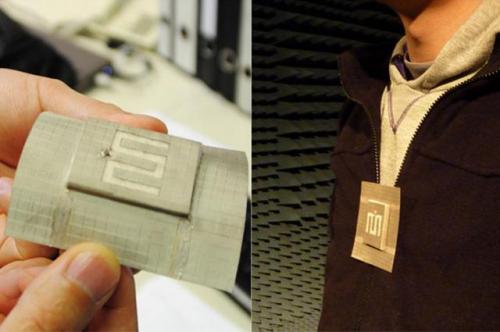
Image of the WLAN antenna via Phys.org
Wireless technology is inevitably being integrated into everything we know, and soon it will be included in our clothing. A textile waveguide antenna has been created by developers at Katholieke Universiteit Leuven and Universiti Malaysia Perlis. By using a metamaterial-like unit cell with transmission lines, the antenna has made progress from an idea to a more tangible concept. When this technology actually happens, we can be walking Wi-Fi signals.
The textile waveguide antenna is small and tough, and is capably used by 2.45 and 5.4 GHz WLAN applications, and will be able to transmit a nice portable Wi-Fi signal. Successfully mixing wireless technology with clothing has been a long-term future goal for many important industries all around the world. Militaristic forces could take specific interest in this technology, for this could help with tracking troops, communicating while in the field, and to monitor soldiers’ vital signs. Even hospitals could start using this technology to medically monitor the patients at all times.
This wearable technology, that takes the form of clothing, will look and feel like normal garments. The fabric-based antennas are unlike regularly bulky antenna structures. Although this idea seems absolutely wonderful, there are some issues in regards to wearing a device with integrated Wi-Fi on your body. The proximity to antennas on your body creates a dangerous electromagnetic reaction. The abrasion caused on the body from the antenna is hazardous to your health, while the interaction your body has with the antenna can cause the device to malfunction. The wired fabric also must withstand vigorous wear and flexibility against the human body. These factors still need to be carefully analyzed, as solutions still need to be figured out for these arising problems.
So far, the antenna developed has a single cell embedded in the topology of the structure. This enables the field distribution of energy to be monitored within the antenna. This helps keep the underlying design compactly robust yet discreet. The device is mounted on top of a felt substrate that is customized to emit radiation and near-field distributions through the two different modes of wireless frequency bands. The human body can be protected from the signals when a ground plane is used from an externally produced shielding textile. The researchers have published their findings in the latest issue of Electronics Letters .
“This wearable textile antenna was developed within the framework of a project aiming at an integrated solution for monitoring, locating, alerting and communicating with senior citizens in an indoor environment,” stated Sen Yan, a researcher at Katholieke Universiteit Leuven. “The system is to be deployed in the form of a network of low-cost wireless sensors within a home. For real-time alerting in the event of emergencies it uses a stepped frequency continuous wave radar concept, combined with dedicated signal processing capabilities. The integration of an electronic module with the textile antenna, that contains several vital-sign sensors, a microcontroller and a wireless communication module, will complete the worn part of this system.”
This technology will continue to develop and advance further within the years to come. Technical textiles will be perfectly developed as circuit technology improves and all factors are analyzed appropriately. The researchers know that this form of wearable technology will not be fully actualized at least for another decade.
Story via Phys.org
Advertisement
Learn more about Electronic Products Magazine






